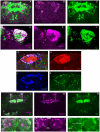The hector G-protein coupled receptor is required in a subset of fruitless neurons for male courtship behavior
- PMID: 22140564
- PMCID: PMC3227663
- DOI: 10.1371/journal.pone.0028269
The hector G-protein coupled receptor is required in a subset of fruitless neurons for male courtship behavior
Abstract
Male courtship behavior in Drosophila melanogaster is controlled by two main regulators, fruitless (fru) and doublesex (dsx). Their sex-specific expression in brain neurons has been characterized in detail, but little is known about the downstream targets of the sex-specific FRU and DSX proteins and how they specify the function of these neurons. While sexual dimorphism in the number and connections of fru and dsx expressing neurons has been observed, a majority of the neurons that express the two regulators are present in both sexes. This poses the question which molecules define the sex-specific function of these neurons. Signaling molecules are likely to play a significant role. We have identified a predicted G-protein coupled receptor (GPCR), CG4395, that is required for male courtship behavior. The courtship defect in the mutants can be rescued by expression of the wildtype protein in fru neurons of adult males. The GPCR is expressed in a subset of fru-positive antennal glomeruli that have previously been shown to be essential for male courtship. Expression of 4395-RNAi in GH146 projection neurons lowers courtship. This suggests that signaling through the CG4395 GPCR in this subset of fru neurons is critical for male courtship behavior.
Conflict of interest statement
Figures






Similar articles
-
Turning males on: activation of male courtship behavior in Drosophila melanogaster.PLoS One. 2011;6(6):e21144. doi: 10.1371/journal.pone.0021144. Epub 2011 Jun 22. PLoS One. 2011. PMID: 21731661 Free PMC article.
-
A gene necessary for normal male courtship, yellow, acts downstream of fruitless in the Drosophila melanogaster larval brain.J Neurobiol. 2003 Apr;55(1):53-72. doi: 10.1002/neu.10196. J Neurobiol. 2003. PMID: 12605459
-
Fruitless specifies sexually dimorphic neural circuitry in the Drosophila brain.Nature. 2005 Nov 10;438(7065):229-33. doi: 10.1038/nature04229. Nature. 2005. PMID: 16281036
-
Neuroethology of male courtship in Drosophila: from the gene to behavior.J Comp Physiol A Neuroethol Sens Neural Behav Physiol. 2014 Apr;200(4):251-64. doi: 10.1007/s00359-014-0891-5. Epub 2014 Feb 25. J Comp Physiol A Neuroethol Sens Neural Behav Physiol. 2014. PMID: 24567257 Review.
-
From fruitless to sex: On the generation and diversification of an innate behavior.Genes Brain Behav. 2021 Nov;20(8):e12772. doi: 10.1111/gbb.12772. Epub 2021 Oct 21. Genes Brain Behav. 2021. PMID: 34672079 Review.
Cited by
-
Molecular Profiling of the Drosophila Antenna Reveals Conserved Genes Underlying Olfaction in Insects.G3 (Bethesda). 2019 Nov 5;9(11):3753-3771. doi: 10.1534/g3.119.400669. G3 (Bethesda). 2019. PMID: 31527046 Free PMC article.
-
Phylogenetic investigation of Peptide hormone and growth factor receptors in five dipteran genomes.Front Endocrinol (Lausanne). 2013 Dec 16;4:193. doi: 10.3389/fendo.2013.00193. eCollection 2013. Front Endocrinol (Lausanne). 2013. PMID: 24379806 Free PMC article.
-
The Drosophila dopamine 2-like receptor D2R (Dop2R) is required in the blood brain barrier for male courtship.Genes Brain Behav. 2023 Feb;22(1):e12836. doi: 10.1111/gbb.12836. Epub 2023 Jan 13. Genes Brain Behav. 2023. PMID: 36636829 Free PMC article.
-
The nuclear receptor Hr46/Hr3 is required in the blood brain barrier of mature males for courtship.PLoS Genet. 2022 Jan 25;18(1):e1009519. doi: 10.1371/journal.pgen.1009519. eCollection 2022 Jan. PLoS Genet. 2022. PMID: 35077443 Free PMC article.
-
QTL Mapping and Marker Identification for Sex-Determining: Indicating XY Sex Determination System in the Swimming Crab (Portunus trituberculatus).Front Genet. 2018 Aug 23;9:337. doi: 10.3389/fgene.2018.00337. eCollection 2018. Front Genet. 2018. PMID: 30210528 Free PMC article.
References
-
- Billeter JC, Rideout EJ, Dornan AJ, Goodwin SF. Control of male sexual behavior in Drosophila by the sex determination pathway. Curr Biol. 2006;16:R766–776. - PubMed
-
- Manoli DS, Meissner GW, Baker BS. Blueprints for behavior: genetic specification of neural circuitry for innate behaviors. Trends Neurosci. 2006;29:444–451. - PubMed
-
- Villella A, Hall JC. Neurogenetics of courtship and mating in Drosophila. Adv Genet. 2008;62:67–184. - PubMed
-
- Yamamoto D. The neural and genetic substrates of sexual behavior in Drosophila. Adv Genet. 2007;59:39–66. - PubMed
Publication types
MeSH terms
Substances
LinkOut - more resources
Full Text Sources
Molecular Biology Databases

